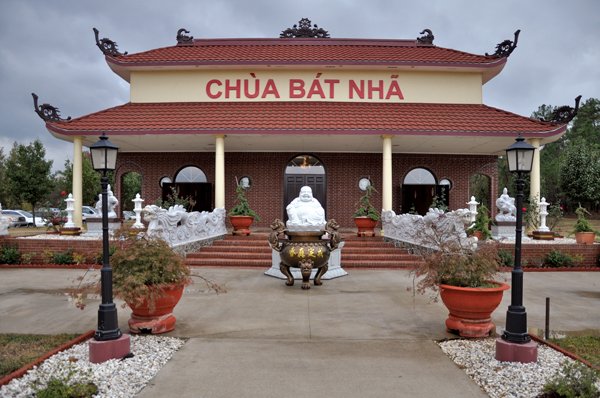BAUXITE — Like so many highways in Arkansas, Arkansas 183, better known as Reynolds Road, starts to get a little rural as it stretches between communities. As the strip malls of booming Bryant give way to trees and cows that creep up to the highway en route to Bauxite, just past the regional airport and a small bridge, a gravel road turns off to the right and leads to something unexpected in this setting: a Buddhist temple.
On approach, one first notices the gate to the grounds, obviously of Asian architectural influence. Behind it, a lamp-lined courtyard of fountains and statuary lead up to the main temple building, an ornate one-story structure built at the site where, for 10 years, a largely Vietnamese community of Buddhists has gathered.
This is Chua Bat Nha, and this weekend it will be the site of three days of celebration marking the decennial anniversary, during which it will draw crowds from all over the state and beyond, including larger metropolitan areas like Dallas and Memphis. Some 50 monks from across the country and beyond are to attend.
“It does represent a pretty significant event,” said Cavin Tran, a member of the temple who offered an interpretive tour of the grounds and a meeting with the resident monk, Thich Hanh Hieu, who came to the temple from Vietnam in 2006.
The temple building itself, explains Tran, was not part of the original construction. The community started with a trailer on land that was purchased from a man whose name — Tom — was given to the road that leads to the highway. Tom donated the land for the road to the city to give the temple access. That trailer now sits behind the temple proper, started in 2004, and serves as a place for community meals. Beside it is living quarters for the resident monk, and between the two is a covered area that includes a stage, which will be the site of choir performances and dancing this weekend.
“All this is still a work in progress,” said Tran. “There is a lot planned that has not happened yet.”
But what has happened is impressive. All arranged according to principles of fung shui and mostly imported from Asia, said Tran, the temple courtyard statuary includes a figure of Quan An, a mother goddess whom Tran, raised Catholic, likened to the Virgin Mary. At the base of the steps leading up to the temple doors is a sight more familiar to Western eyes — a jovial, rotund-bellied statue whose placement would be nowhere else and symbolizes luck, Tran said. The steps up to the doors are lined by dragon statues Tran and other temple members installed themselves, each composed of four immensely heavy pieces fused together.
Inside the temple, where shoes are not worn, there are no chairs or pews. Benches line each wall, but at services like the weekly Sunday meeting at 11 a.m., worshippers sit directly on the ground or on small round cushions. They face an altar-like area of dark wood replete with statuary, where monks lead with chanting and songs. Dominating the room is a larger-than-life figure of the Buddha, a new addition for the temple when it moved into the larger building.
Behind this room, a long hall contains both a statue of the teacher who brought Buddhism to China (and thus ultimately to Vietnam) as well as a place for pictures of deceased temple members, usually an early stop for practitioners when they arrive as they pray for their rebirth into a better life or their escape from the cycle of rebirth central to Buddhist philosophy. The anniversary celebration, says monk Thich Hanh Hieu through translator Tran, will include a ceremony to remember those who have died — not just from the temple, but all deaths, with no distinctions.
Indeed, those who come will find the temple to be very inclusive, its members say, welcoming of everyone from school groups to tourists. The Bauxite mayor has been there, and Tran said he's brought guests including a Hendrix professor and out-of-towners, too. Last weekend it played host to a wedding with 200 guests for a non-Buddhist couple who loved the beauty of the site. It's held non-Buddhist funerals and other events appropriate to the venue as a religious site and “what we're allowed to do,” said Tran. Indeed, his own ideal is to have a shrine in downtown Little Rock describing the temple and either organized or individual trips from there to the temple.
“This is a place to believe in, to talk to the monk to get a clear mind,” said Tran. “It is a mentally and spiritually supportive place … and we welcome people who are curious about either Buddhism as a religion or its culture.
“We don't want to commercialize but to advertise our existence here. Only by word of mouth do people know about this place,” he said. “It's not just a place of worship. A lot of things tie into it — social, supportive and teaching … [it's] a place for Vietnamese culture and tradition.”
But it is not a place for politics. Outside the temple, visitors will see the Buddhist flag but not the flag of Vietnam, neither the communist nor the old flag. They are forbidden by the monk.
While services are in Vietnamese, it's been a place that has been a welcome find — literally — for Bill Gotherman. A practicing Buddhist who lived in the area, he said he became aware of the temple a few years ago when a co-worker told him about it. He'd literally discovered it while searching for a place to ride his four wheeler.
“I don't understand everything [that's said], but I know these words are holy,” said Gotherman as he awaited a recent Sunday service. “So just by hearing them I am getting the blessing.”
